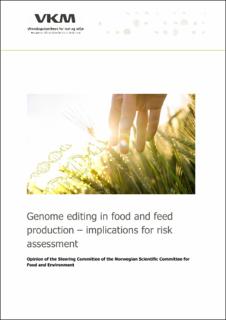Genome editing in food and feed production – implications for risk assessment. Scientific Opinion of the Scientific Steering Committee of the Norwegian Scientific Committee for Food and Environment
Bodin, Johanna Eva; Thorstensen, Tage; Alsheikh, Muath K; Basic, Dean; Edvardsen, Rolf Brudvik; Dalen, Knut Tomas; Duale, Nur; Eklo, Ole Martin; Ergon, Åshild Gunilla; Jevnaker, Anne-Marthe Ganes; Hindar, Kjetil; Håvarstein, Leiv Sigve; Malmstrøm, Martin; Nielsen, Kaare Magne; Olsen, Siri Lie; Rueness, Eli Knispel; Sanden, Monica; Sipinen, Ville Erling; von Krogh, Kristine; Våge, Dag Inge; Wargelius, Anna; Wendell, Per Hans Micael; Yazdankhah, Siamak Pour; Alexander, Jan; Bruzell, Ellen Merete; Hemre, Gro Ingunn; Vandvik, Vigdis; Agdestein, Angelika; Elvevoll, Edel O.; Hessen, Dag Olav; Hofshagen, Merete; Husøy, Trine; Knutsen, Helle Katrine; Krogdahl, Åshild; Nilsen, Asbjørn Magne; Rafoss, Trond; Skjerdal, Olaug Taran; Steffensen, Inger-Lise Karin; Strand, Tor Arne; Velle, Gaute; Wasteson, Yngvild
Peer reviewed, Journal article
Accepted version

Permanent lenke
https://hdl.handle.net/11250/2991165Utgivelsesdato
2021Metadata
Vis full innførselSamlinger
- Artikler [5068]
- Publikasjoner fra CRIStin FHI [7544]
Originalversjon
VKM Report. 2021, 2021 (18), .Sammendrag
The Norwegian Scientific Committee for Food and Environment (VKM) initiated this work to examine the extent to which organisms developed by genome-editing technologies pose new challenges in terms of risk assessment. This report considers whether the risk assessment guidance on genetically modified organisms, developed by the European Food Safety Authority (EFSA), can be applied to evaluate potential risks of organisms developed by genome editing. Background Gene technology has allowed for the transfer of genes between organisms and species, and thereby to design altered genotypes with novel traits, i.e. GMOs. A new paradigm started in the early 2000s with the development of genome-editing techniques. Unlike traditional genetic modification techniques resulting in insertion of foreign DNA fragments at random locations in the genome, the new genome-editing techniques additionally open for a few single nucleotide edits or short insertions/deletions at a targeted site in an organism’s genome. These new techniques can be applied to most types of organisms, including plants, animals and microorganisms of commercial interest. An important question is how the novel, genome-edited organisms should be evaluated with respect to risks to health and the environment. The European Court of Justice decided in 2018 to include genome-edited organisms in the GMO definition and hence in the regulatory system already in place. This implies that all products developed by genome-editing techniques must be risk-assessed within the existing regulatory framework for GMOs. The European and Norwegian regulatory frameworks regulate the production, import and placing on the market of food and feed containing, consisting of or produced from GMOs, as well as the release of GMOs into the environment. The assessment draws on guidance documents originally developed by EFSA for risk assessment of GMOs, which were drawn up mainly to address risks regarding insertion of transgenes. The new genome-editing techniques, however, provide a new continuum of organisms ranging from those only containing a minor genetic alteration to organisms containing insertion or deletion of larger genomic regions. Risk assessment of organisms developed by genome editing The present discourse on how new genome-editing techniques should be regulated lacks an analysis of whether risk assessment methodologies for GMOs are adequate for risk assessment of organisms developed through the use of the new genome-editing techniques. Therefore, this report describes the use of genome-editing techniques in food and feed production and discusses challenges in risk assessment with the regulatory framework. Specifically, this report poses the question as to whether the EFSA guidance documents are sufficient for evaluating risks to health and environment posed by genome-edited plants, animals and microorganisms. To address these questions, the report makes use of case examples relevant for Norway. These examples, intended for food and feed, include oilseed rape with a modified fatty acid profile, herbicide-tolerant and pest-resistant crops, sterile salmon, virus-resistant pigs and hornless cattle. The report considers all aspects of the stepwise approach as described in the EFSA guidance documents. Conclusions The inherent flexibility of the EFSA guidance makes it suitable to cover health and environmental risk assessments of a wide range of organisms with various traits and intended uses. Combined with the embedded case-by-case approach the guidance is applicable to genome-edited organisms. The evaluation of the guidance demonstrates that the parts of the health and environmental risk assessment concerned with novel traits (i.e. the phenotype of the organism) may be fully applied to all categories of genome-edited organisms. ............